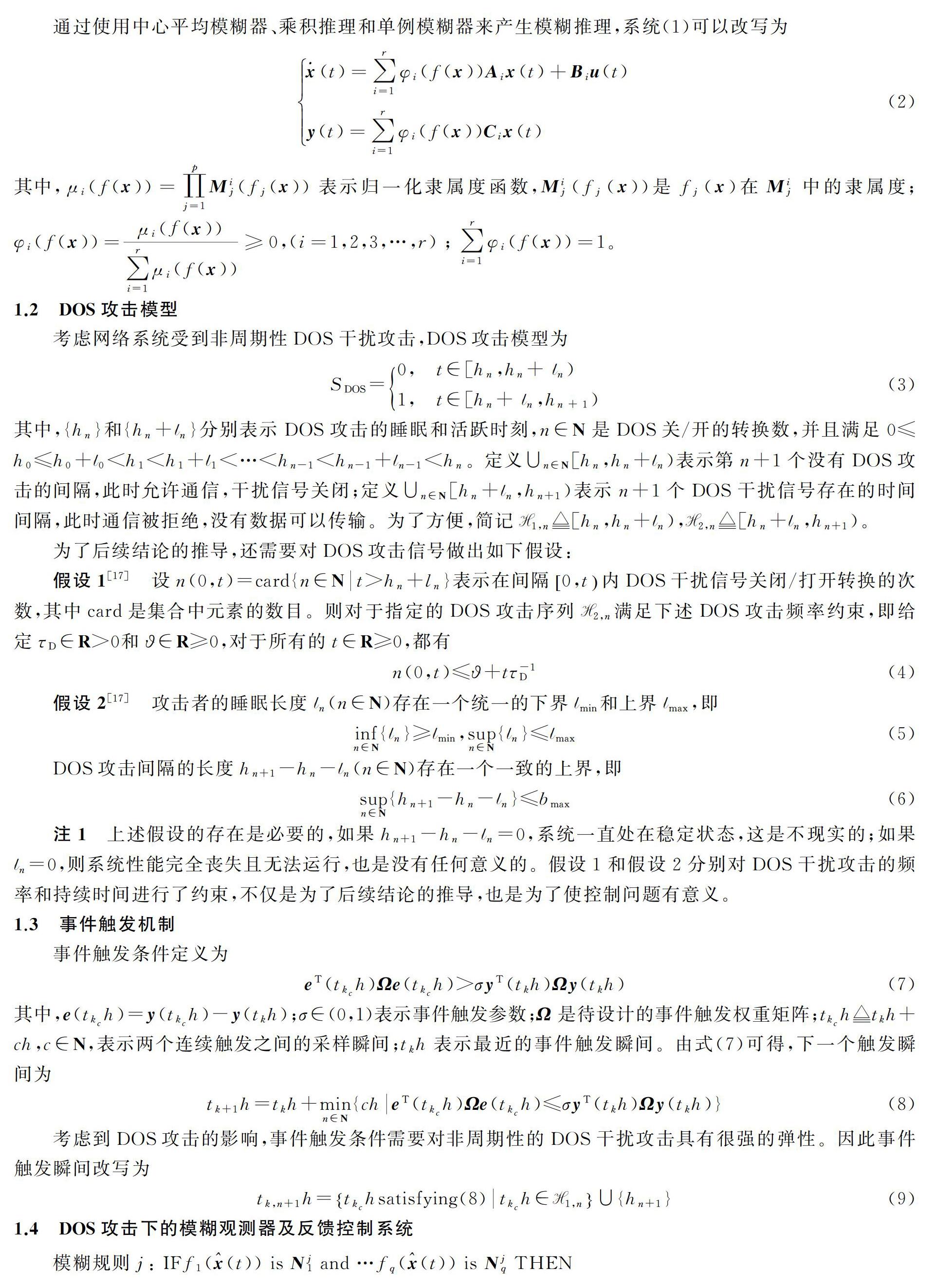DOS攻击下非线性NCSs观测器与控制器协同设计
2021-07-20胡亚猛林崇
胡亚猛 林崇



摘要: 針对网络系统中存在的阻碍网络通信问题,本文基于观测器,研究了一类非线性网络控制系统在非周期拒绝服务(denial of service,DOS)攻击下的控制问题。设计了一种弹性事件触发方案,并充分考虑非周期DOS攻击和事件触发方案的影响,基于TS模糊模型,建立了一种切换系统模型。通过构造LyapunovKrasovskii泛函,并基于线性矩阵不等式方法,分析了系统的渐近稳定性,提出了一种控制器和观测器的协同设计方法。最后,以文献[13]中的卡车拖车系统为例,通过Matlab的LMI工具箱进行仿真验证。仿真结果表明,切换系统在非周期的DOS攻击下是渐进稳定的,验证了所得结果的有效性。该研究对非线性网络控制系统抵抗外部攻击具有重要意义。
关键词: DOS攻击; 网络控制系统; LyapunovKrasovskii泛函; 事件触发方案; 控制器
中图分类号: TP271.62 文献标识码: A
4 结束语
本文结合文献[13]提出的网络化TS模糊系统基于观测器的控制器设计方法,引入了非周期的DOS干扰攻击下,将文献[15]中线性网络系统在周期性DOS攻击下基于观测器的控制器设计问题推广至非线性系统。为了应对非周期性的DOS干扰攻击,提出了一种动态事件触发方案,并且充分考虑了事件触发方案和DOS干扰攻击对原系统前提变量和隶属度函数的影响,建立了基于TS模糊模型的切换系统模型。在此基础上,提出了观测器、控制器和事件触发方案的协同设计方法,并通过仿真实例,验证了本文所提出设计方法的有效性。下一步将考虑存在的外部干扰情况或考虑其他攻击方式,例如欺诈攻击和混合攻击。
参考文献:
[1] Zhang X M, Han Q L, Ge X H, et al. Networked control systems: a survey of trends and techniques[J]. IEEE/CAA Journal of Automatica Sinica, 2020, 7(1): 117.
[2] Liu D, Yang G H, Er M J. Eventtriggered control for TS fuzzy systems under asynchronous network communications[J]. IEEE Transactions on Fuzzy Systems, 2020, 28(2): 390399.
[3] Zhang L X, Gao H J, Kaynak O. Networkinduced constraints in networked control systemsa survey[J]. Industrial Informatics IEEE Transactions on Industrial Informatics, 2013, 9(1): 403416.
[4] Tabuada P. Eventtriggered realtime scheduling of stabilizing control tasks[J]. IEEE Transactions on Automatic Control, 2007, 52(9): 16801685.
[5] You X, Hua C C, Guan X P. Selftriggered leaderfollowing consensus for highorder nonlinear multiagent systems via dynamic output feedback control[J]. IEEE Transactions on Cybernetics, 2019, 49(6): 20022010.
[6] Zhang J H, Feng G. Eventdriven observerbased output feedback control for linear systems[J]. Automatica, 2014, 50(7): 18521859.
[7] Takagi T, Sugeno M. Fuzzy identification of systems and its applications to modeling and control[J]. Readings in Fuzzy Sets for Intelligent Systems, 1993, 15(1): 387403.
[8] Lam H K. A review on stability analysis of continuoustime fuzzymodelbased control systems: From membershipfunctionindependent to membershipfunctiondependent analysis[J]. Engineering Applications of Artificial Intelligence, 2018, 67: 390408.
[9] Ye D, Diao N N, Zhao X G. Faulttolerant controller design for general polynomialfuzzymodelbased systems[J]. IEEE Transactions on Fuzzy Systems, 2018, 26(2): 10461051.
[10] Dong J X, Yang G H. Stability analysis of TS fuzzy control systems by using set theory[J]. IEEE Transactions on Fuzzy Systems, 2014, 23(4): 827841.
[11] Li H Y, Pan Y N, Shi P, et al. Switched fuzzy output feedback control and its application to massspringdamping system[J]. IEEE Transactions on Fuzzy Systems, 2016, 24(6): 12591269.
[12] Zhang K, Jiang B, Shi P, et al. Analysis and design of robust H∞ fault estimation observer with finitefrequency specifications for discretetime fuzzy systems[J]. IEEE Transactions on Cybernetics, 2015, 45(7): 12251235.
[13] Peng C, Ma S D, Xie X P. Observerbased nonPDC control for networked TS fuzzy systems with an eventtriggered communication[J]. IEEE Transactions on Cybernetics, 2017, 47(8): 22792287.
[14] Zhao X, Lin C, Chen B, et al. Adaptive eventtriggered fuzzy H∞ filter design for nonlinear networked systems[J]. IEEE Transactions on Fuzzy Systems, 2019, 28(12): 33023314.
[15] Hu S L, Yue D, Han Q L, et al. Observerbased eventtriggered control for networked linear systems subject to denialofservice attacks[J]. IEEE Transactions on Cybernetics, 2020, 50(5): 19521964.
[16] Gu Z, Zhou X H, Zhang T, et al. Eventtriggered filter design for nonlinear cyberphysical systems subject to deception attacks.[J]. ISA Transactions, 2019, 104: 130137.
[17] De Persis C, Tesi P. Inputtostate stabilizing control under denialofservice[J]. IEEE Transactions on Automatic Control, 2015, 60(11): 29302944.
[18] Seuret A, Frederic G. Wirtingerbased integral inequality: Application to timedelay systems[J]. Automatica, 2013, 49(9): 28602866.
[19] Zhang X M, Han Q L, Seuret A, et al. An improved reciprocally convex inequality and an augmented LyapunovKrasovskii functional for stability of linear systems with timevarying delay[J]. Automatica, 2017, 84: 221226.
